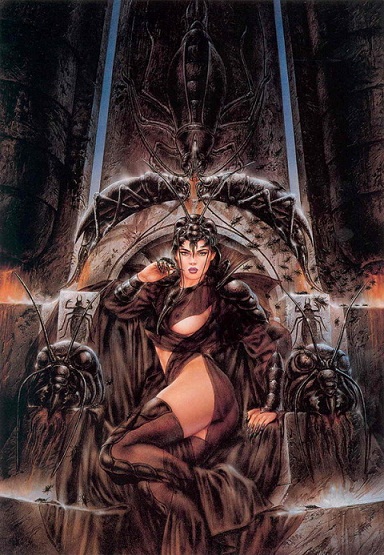[center]
[large]The Necronomicon[/large][/center]
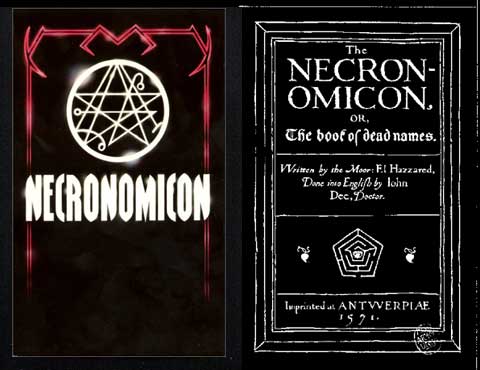
[justify]Le Necronomicon est un ouvrage fictif inventé par l'écrivain américain H.P. Lovecraft, vraisemblablement à l'occasion de la rédaction de la nouvelle « La Cité sans nom », achevée en 1921. Bien que le texte en lui-même ne donne pas le nom de Necronomicon, il présente en revanche pour la première fois l'auteur de fiction Abdul Al-Hazred, ainsi que les vers : « N'est pas mort ce qui à jamais dort, Et au cours des siècles peut mourir même la Mort ». C'est la nouvelle de 1922 « Le Molosse » (parue en 1924) qui utilise le titre pour la première fois. En 1927, Lovecraft détailla l'histoire fictive de cet ouvrage afin d'éviter les possibles futures incohérences entre ses nouvelles qui l'évoqueraient. Diverses sources ont été utilisées par l'auteur afin de créer un ouvrage crédible. En tout, le Necronomicon est évoqué dans treize nouvelles : parfois seulement le titre, une ou deux phrases ou un paragraphe complet.[/justify]
[justify]Après diverses références dans ses nouvelles au Necronomicon, Lovecraft décida en 1927 de mettre au clair, au moins pour lui au départ, l'histoire du livre afin d'éviter toutes incohérences futures. Il semblerait que Lovecraft se soit inspiré des histoires des grimoires évoquées par Arthur Edward Waite dans son Book of Black Magic and of Pacts de 1898. Ce texte n'eut d'abord que cette fonction de cohérence fictionnelle. Il l'envoya cependant à ses amis qui le lui demandaient. Finalement, le texte fut publié sous forme de nouvelle (« Histoire du Necronomicon ») après sa mort.
Selon les divers textes de Lovecraft évoquant l'ouvrage, le Necronomicon, originellement nommé Kitab al Azif (littéralement « Livre du musicien ») aurait été écrit vers 730 à Damas par le poète Abdul al-Hazred, souvent surnommé « l'Arabe dément » par l'auteur. En arabe, al azif fait référence au bruit que produisent les insectes la nuit, ce qui dans cette culture se rapporte aux cris des djinns. Le manuscrit original en arabe aurait disparu.
Théodore Philetas de Constantinople aurait par la suite traduit l'ouvrage en grec ancien vers 950, et c'est lui qui attribua à l'?uvre le titre par lequel elle est la plus connue : Necronomicon. Le patriarche de Constantinople Michel Cérulaire fit brûler toutes les copies grecques en 1050 mais quelques exemplaires auraient échappé aux flammes.
Il aurait été traduit en espagnol par Jean de Seville.
Olaus Wormius en rédigea une traduction en latin en 1228. Les versions grecque et latine furent interdites par le pape Grégoire IX en 1232. Wormius fut mis au bûcher par la Sainte Inquisition avec tous les exemplaires. Seules quelques copies auraient subsisté, peut-être parce que l'ouvrage avait été mis à l?Index Librorum Prohibitorum selon une autre version de l'histoire par Lovecraft, notamment dans les archives secrètes du Vatican. Une version en caractères gothiques apparut en Allemagne vers 1440, et le texte grec ressurgit en Italie au cours de la première moitié du XVIe siècle, suivi d'une traduction en espagnol vers 1600. Entre temps, en 1583, John Dee et Edward Kelley, deux occultistes britanniques qui travaillaient pour le compte de l'empereur Rodolphe II, (qui auparavant avaient déjà été employés par la reine Elisabeth Ire), se seraient procuré un exemplaire du livre. John Dee en publia une version anglaise, au préalable cryptée, en 1586, dont il ne subsite que des fragments. Le dernier exemplaire de l'édition italienne du XVIe siècle aurait été brûlé à l'issue des procès de Salem en 1692.[/justify]
[center]
Lovecraft Phillips Howard - Collected works
[large]http://www.balderexlibris.com/index.php ... cted-works[/large][/center]
[justify][small]Notes On Writing Weird Fiction History of the Necronomicon At the Mountains of Madness Azathoth Beyond the Wall of Sleep Celephais Cool Air Dagon Dreams in the Witch-House Ex Oblivione Facts Concerning the Late Arthur Jermyn and His Family From Beyond He Herbert West: Reanimator Hypnos Ibid Imprisoned with the Pharaos In The Vault Memory Nyarlathotep Pickman?s Model Polaris The Alchemist The Beast in the Cave The Book The Call of Cthulhu The Case of Charles Dexter Ward The Cats of Ulthar The Colour Out of Space The Descendant The Doom That Came to Sarnath The Dream Quest of Unknown Kadath The Dunwich Horror The Evil Clergyman The Festival The Haunter Of The Dark The Horror at Red Hook The Horror in the Museum The Hound The Music OF Erich Zann The Nameless City The Other Gods The Outsider The Picture in the House The Quest of Iranon The Rats in the Walls The Shadow Out of Time The Shadow Over Innsmouth The Shunned House The Silver Key The Statement of Randolph Carter The Strange High House in the Mist The Street The Temple The Terrible Old Man The Thing on the Doorstep The Tomb The Transition of Juan Romero The Tree The Unnamable The Very Old Folk The Whisperer in Darkness The White Ship What the Moon Brings Medusa?s Coil - with Zealia Bishop Out of the Aeons - with Hazel Heald Poetry and the Gods - with Anna Helen Crofts The Crawling Chaos - with Elizabeth Berkeley The Disinterment - with Duane W. Rimel The Green Meadow - with Winifred V. Jackson The Horror at Martin?s Beach - with Sonia H. Greene The Last Test - with Adolphe de Castro The Man of Stone - with Hazel Heald The Night Ocean - with R. H. Barlow The Thing in the Moonlight - with J. Chapman Miske The Trap - with Henry S. Whitehead The Tree On The Hill - with Duane W. Rimel Through the Gates of the Silver Key - with E. Hoffmann Price Till A? the Seas - with R. H Barlow Two Black Bottles - with Wilfred Blanch Talman Within the Walls of Eryx - with Kenneth Sterling At the Root Cats And Dogs Letter to August Derleth Metrical Regularity The Allowable Rhyme The Despised Pastoral An American to Mother England Astrophobos Christmas Blessings Christmastide Despair Fact and Fancy Festival Fungi from Yuggoth Hallowe?en in a Suburb Laeta; A Lament Lines on General Robert Edward Lee Little Tiger Nathicana Nemesis Ode for July Fourth, 1917 On Reading Lord Dunsany?s Book of Wonder On Receiving a Picture of Swans Pacifist War Song - 1917 Poemata Minora Providence Revelation The Bride of the Sea The Cats The City The Conscript The Garden The House The Messenger The Peace Advocate The Poe-et?s Nightmare The Rose of England The Wood To Edward John Moreton Drax Plunkelt, Eighteenth Baron Dunsany Tosh Bosh Waste Paper: A Poem of Profound Insignificance Where Once Poe Walked[/small][/justify]
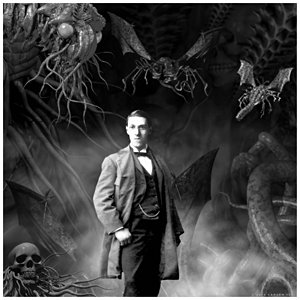
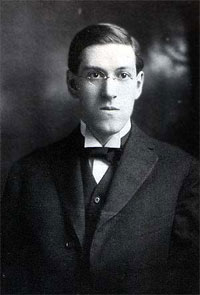 [justify]Howard Phillips Lovecraft, né le 20 août 1890 et mort le 15 mars 1937, est un écrivain américain.
[justify]Howard Phillips Lovecraft, né le 20 août 1890 et mort le 15 mars 1937, est un écrivain américain.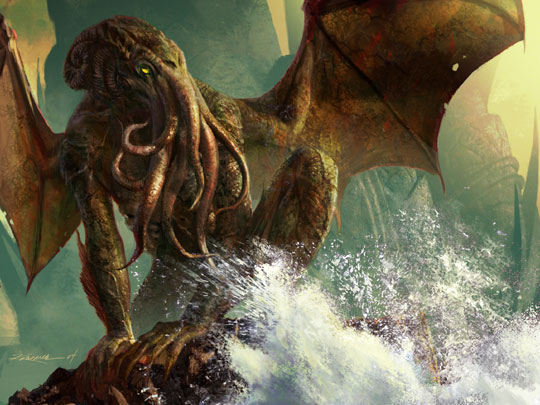
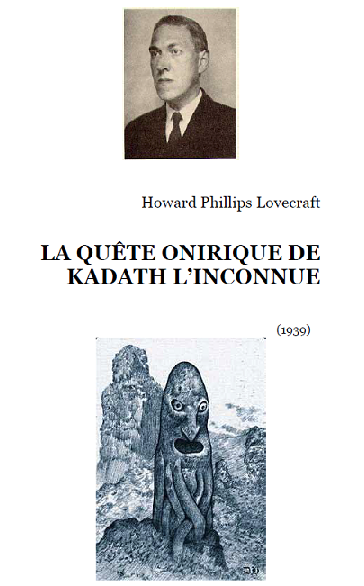 [justify]Randolf Carter rêve par trois fois d'une majestueuse cité coucher de soleil, mais chaque fois il est brutalement arraché du rêve avant d'en voir plus. Aussi prie-t-il les dieux du rêve de lui révéler des alentours de cette ville fantastique. Non seulement ceux-ci ne répondent pas, mais les rêves de la cité disparaissent en même temps. Carter se résigne à aller à Kadath, la demeure des dieux, pour les implorer en personne. Cependant personne n'a jamais vu Kadath et personne ne sait même comment y aller. En rêve, Randolf Carter descend les 70 marches des cavernes de la flamme et parle de ses plans au prêtres du temple qui jouxte les frontières du monde du rêve et du monde de l'éveil. Les prêtes avertissent Carter des grands dangers qu'il encourt.
[justify]Randolf Carter rêve par trois fois d'une majestueuse cité coucher de soleil, mais chaque fois il est brutalement arraché du rêve avant d'en voir plus. Aussi prie-t-il les dieux du rêve de lui révéler des alentours de cette ville fantastique. Non seulement ceux-ci ne répondent pas, mais les rêves de la cité disparaissent en même temps. Carter se résigne à aller à Kadath, la demeure des dieux, pour les implorer en personne. Cependant personne n'a jamais vu Kadath et personne ne sait même comment y aller. En rêve, Randolf Carter descend les 70 marches des cavernes de la flamme et parle de ses plans au prêtres du temple qui jouxte les frontières du monde du rêve et du monde de l'éveil. Les prêtes avertissent Carter des grands dangers qu'il encourt.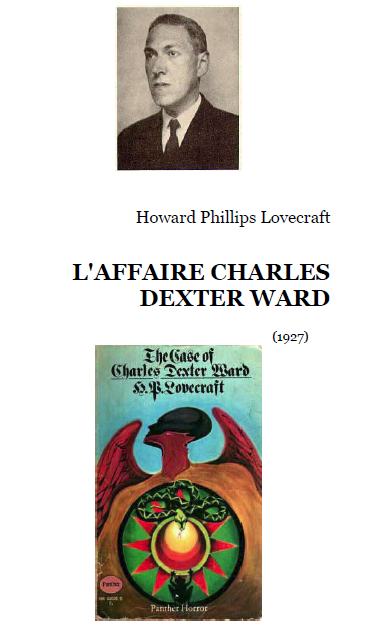 [center][large]L'Affaire Charles Dexter Ward[/large][/center]
[center][large]L'Affaire Charles Dexter Ward[/large][/center]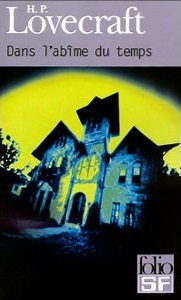 [center][large]Dans l'abime du temps[/large][/center]
[center][large]Dans l'abime du temps[/large][/center]